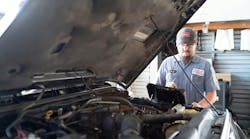I come from a Ford family. My Dad retired from Ford in 1989, I have two brothers still employed there, and I worked at the company for ten years in many roles, including production supervisor.
This history helps explain my interest in the Ford Escape hybrid. I placed my order for one in 2003, even though they weren’t available until 2005. However, my captivation went deeper than brand loyalty. I recognized that, as an owner-operator of an automotive service and repair business, alternative propulsion vehicles were part of my future.
As soon as I got my Escape, I sought training in safety procedures and other unique aspects of the vehicle. This training continues on an annual basis to keep me and my technicians at each of our 12 locations up to speed.
A ballpark estimate of the cost of training and additional tools and equipment, per facility, is about $5,000.
In Cleveland, and likely in most regions, other than the West Coast, hybrid service is a slow growing market segment, but that doesn’t mean it’s not important. In fact, the ROI for this service niche can be quite good.
With GM on track to release the 238-mile range all electric Chevy Bolt any day now, and Tesla taking thousands of orders for their Model 3 in concert with the construction of a $1 billion lithium ion battery factory in Nevada and the popularity of Nissan’s Leaf among others, it’s clear that a consumer level, daily driver all electric car that meets the needs of 90 percent of drivers is basically here now.
Although we are making inroads, we are still held back by the availability of good replacement drive batteries. Replacement batteries make up about 50 percent of the hybrid jobs that come in the door, even though batteries exhibit significant longevity. The vehicles we see needing replacements are 8 to 10 years old, and have racked up 100,000, 150,000 or more miles.
When it comes to HVAC service and repair, the hybrids we’ve seen so far are not radically different from other vehicles that come into our shops, with the exception of electric compressors versus belt driven, and different oils, but that may change.
To read more content from MACS, visit https://macsworldwide.wordpress.com/


